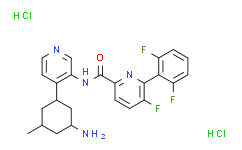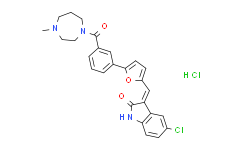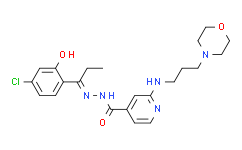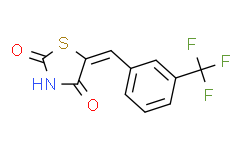| 中文名称: | PIM-447 dihydrochloride | ||||
|---|---|---|---|---|---|
| 英文名称: | PIM-447 dihydrochloride | ||||
| 别名: | LGH447 dihydrochloride | ||||
| CAS No: | 1820565-69-2 | 分子式: | C24H25Cl2F3N4O | 分子量: | 513.38 |
| CAS No: | 1820565-69-2 | ||||
| 分子式: | C24H25Cl2F3N4O | ||||
| 分子量: | 513.38 | ||||
基本信息
|
产品编号: |
P10799 |
||||
|
产品名称: |
PIM-447 dihydrochloride |
||||
|
CAS: |
1820565-69-2 |
储存条件 |
粉末 |
-20℃ |
四年 |
|
|
|
||||
|
分子式: |
溶于液体 |
-80℃ |
6个月 |
||
|
分子量: |
513.38 |
-20℃ |
1个月 |
||
|
化学名: |
|||||
|
Solubility (25°C): |
|||||
|
体外:
|
DMSO |
|
|||
|
Ethanol |
|
||||
|
Water |
|
||||
|
体内(现配现用): |
|
||||
|
<1mg/ml表示微溶或不溶。 |
|||||
|
普西唐提供的所有化合物浓度为内部测试所得,实际溶液度可能与公布值有所偏差,属于正常的批间细微差异现象。 |
|||||
|
请根据产品在不同溶剂中的溶解度选择合适的溶剂配制储备液;⼀旦配成溶液,请分装保存,避免反复冻融造成的产品失效。 |
|||||
制备储备液
|
浓度
溶液体积 质量 |
1mg |
5mg |
10mg |
|
1mM |
1.9479mL |
9.7394mL |
19.4787mL |
|
5mM |
0.3896mL |
1.9479mL |
3.8957mL |
|
10mM |
0.1948mL |
0.9739mL |
1.9479mL |
生物活性
|
产品描述 |
一种有效的、口服的、选择性的泛PIM激酶抑制剂,对PIM1、PIM2和PIM3 的Ki值分别为6、18和9pM。 |
|
|
靶点 |
Ki:6pM (PIM1);18pM (PIM1);9pM (PIM3) |
|
|
体外研究 |
PIM-447 (0.05-10µM;24,48 and 72 hours) has inhibitory effects in MM cells,it against sensitive cell lines with IC50 values ranging from 0.2 to 3.3µM (MM1S,MM1R,RPMI-8226,MM144,U266 and NCI-H929) and less sensitive cell lines with IC50 values at 48h>7µM (OPM-2,RPMI-LR5,U266-Dox4 and U266-LR7).PIM-447 (0.1-10µM;24,48 and 72 hours) does not induce important levels of apoptosis,when PIM447 at 5µM,it substantially increases annexin-V levels (about 30%) in sensitive cell lines(MM1S,NCI-H929 and RPMI-8226).When PIM447 at 10µM,it induces apoptosis in all the cell lines but to a lesser extent in OPM-2 and RPMI-LR5.PIM447 promotes the cleavage of initiator caspases,such as caspases 8 and 9,and increases the cleavage of the effector caspases 3 and 7,together with PARP cleavage in MM1S,RPMI-8226 and NCI-H929 cells.PIM447 (0.1-1µM) increases the percentage of cells in the G0/G1 phase and decreases the proliferative phases (S and G2/M) of the cell cycle.The effects at low concentrations (0.1-1µM) were more pronounced in MM1S cells than in OPM-2. Cell Viability Assay |
|
|
Cell Line: |
Sensitive MM cell lines:MM1S,MM1R,RPMI-8226,MM144,U266 and NCI-H929 cells Less sensitive MM cell lines:OPM-2,RPMI-LR5,U266-Dox4 and U266-LR7cells |
|
|
Concentration: |
0.05-10µM |
|
|
Incubation Time: |
24,48 and 72 hours |
|
|
Result: |
Was cytotoxic for MM cells (PIM kinases highly expressed). |
|
|
Apoptosis Analysis |
||
|
Cell Line: |
Sensitive MM cell lines:MM1S,NCI-H929 and RPMI-8226 cells Less sensitive MM cell lines:OPM-2 and RPMI-LR5 cells |
|
|
Concentration: |
0.05-10µM |
|
|
Incubation Time: |
24,48 and 72 hours |
|
|
Result: |
Induced cell apoptosis at higer doses, had no effects at 0.1-1uM. |
|
|
Western Blot Analysis |
||
|
Cell Line: |
Sensitive MM cell lines:MM1S,NCI-H929 and RPMI-8226 cells |
|
|
Concentration: |
0.05-10µM |
|
|
Incubation Time: |
24, 48 hours |
|
|
Result: |
Increased the cleavage of the effector caspases 3 and 7,and the PARP cleavage. |
|
|
Cell Cycle Analysis |
||
|
Cell Line: |
MM1S,OPM-2 cells |
|
|
Concentration: |
0.1,0.5 or 1µM |
|
|
Incubation Time: |
48 hours |
|
|
Result: |
Increased the cleavage of the effector caspases 3 and 7,and the PARP cleavage. |
|
|
体内研究 |
PIM447 (oral gavage;100mg/kg;5 times/week) clearly controlls tumor progression and the serum levels of hIgλ secreted by RPMI-8226-luc cells in mouse model of bone marrow-disseminated human multiple myeloma. |
|
|
Animal Model: |
RPMI-8226-luc cells are injected intravenously into 6-week-old female NODSCID-IL-2Rγ-/-(NSG) mice. |
|
|
Dosage: |
100mg/kg |
|
|
Administration: |
oral gavage;100mg/kg;5 times/week |
|
|
Result: |
Was well tolerated,as the body weight of mice did not decrease by more than 10%.Increased bone volume density and trabecular number and reduced trabecular separation relative to vehicle group. |
|
本计算器可帮助您计算出特定溶液中溶质的质量、溶液浓度和体积之间的关系,公式为:
质量 (g) = 浓度 (mol/L) x 体积 (L) x 分子量 (g/mol)
摩尔浓度计算公式
用本工具协助配置特定浓度的溶液,使用的计算公式为:
开始浓度 x 开始体积 = 最终浓度 x 最终体积
稀释公式
稀释公式一般简略地表示为:C1V1 = C2V2 ( 输入 输出 )











